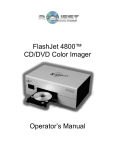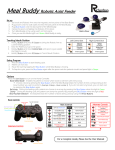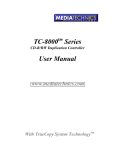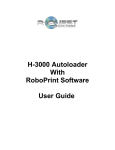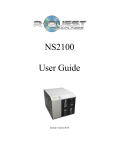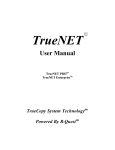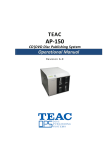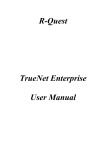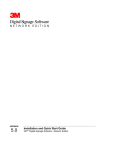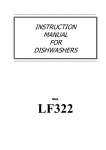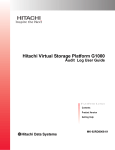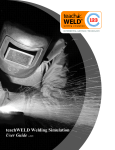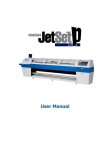Download TCP-7100 User Manual
Transcript
TP-5100tm Disc Print Autoloader User Manual 2 COPYRIGHT___________________________________________________ Copyright © 2002-2008 R-Quest Technologies, LLC. All rights reserved. This manual and the software described in it are copyrighted with all rights reserved. No part of this publication may be reproduced, transmitted, transcribed, stored in a retrieval system or translated into any language in any form by any means without the written permission of R-Quest Technologies, LLC. TRADEMARKS_________________________________________________ R-Quest, R-Quest by R-Quest, CopyQuest, TP-5100, TrueNet, TrueCopy, TrueCopy System Technology, TrueCopy Technology, and Powered By R-Quest are trademarks of R-Quest Technologies, LLC. Other brand names and product names are trademarks or registered trademarks of their respective companies. R-Quest Technologies, LLC. may also claim other names, words or phrases contained in this manual as trademarks. PIRACY / ILLEGAL COPYING_____________________________________ The TP series copiers are designed to help you easily reproduce material for which you own the copyright or have obtained permission from the copyright owner to make copies. Unless you own the copyright or have permission from the copyright owner to make copies, you may be violating copyright law and be subject to payment of fines, damages and / or other remedies. R-Quest Technologies, LLC. accepts no responsibility for the use or misuse of this equipment for illegal purposes. If you are uncertain about your rights, contact your legal advisor. WARRANTY___________________________________________________ R-Quest Technologies, LLC. (hereinafter “R-Quest”) warrants its Products to be free from defects in materials and workmanship under normal and proper usage for the period of one year from the date of shipment from R-Quest. THIS WARRANTY IS IN LIEU OF AND EXCLUDES ALL OTHER REPRESENTATIONS MADE, BOTH EXPRESS AND IMPLIED, INCLUDING WITHOUT LIMITATION, THE IMPLIED WARRANTIES OF MERCHANTABILITY AND FITNESS FOR A PARTICULAR PURPOSE. R-Quest further warrants that the goods sold are as described, but no promise, description, affirmation of fact, sample model or representation, oral or written shall be part of an order, unless set forth in these terms and conditions, or are in writing and signed by an authorized representative of RQuest. This warranty does not apply to any Product which has been subject to misuse, negligence, accident or normal wear and tear - or to any Product which has been modified or repaired, improperly installed, altered, or disassembled -except according to R-Quest’s written instructions. 3 This warranty is subject to the following further conditions: 1) This warranty is limited to the electronic and mechanical performance only, as expressly detailed in the Product specifications and NOT to the imbedded software, firmware or to third party software. 2) This warranty shall not apply to any Products which are stored, or utilized, in harsh environmental or electrical conditions outside R-Quest’s written specifications. 3) This warranty is applicable only to Products shipped from R-Quest subsequent to January 19th 2008. 4) This warranty shall be valid only if the Product was purchased by the End User from an authorized R-Quest Distributor/Reseller. 5) Heavy use (per recorder or printer, 12,000 discs / 100 cartridges) may require consumable items such as printers or recorders to be serviced within the warranty period. Parts replaced in the course of a service are warranted to be free of defects in material and workmanship for a period of ninety (90) days, or until the expiration of the original warranty (whichever is the later), and are subject to the same service interval requirements. 6) Removal of the R-Quest Label or Serial number from the product will void this warranty. 7) Inkjet Printers Only: Use only the appropriate genuine HP cartridges in the FlashJet 4800. Using, or attempting to use cartridge refills or attempting to ‘bulk ink’ the printers will void this warranty. Purchaser’s Remedies If a R-Quest Distributor or an End User desires to make a warranty Claim, the Distributor or End User shall, if requested by R-Quest, ship the Product to RQuest’s authorized service facility, postage or freight prepaid. R-Quest shall, at its option, take one of the following two courses of action for any Products which R-Quest determines are defective in materials or workmanship: 1) Repair or replace the Product and ship the Product to the End User or to the authorized R-Quest Distributor, postage or freight prepaid; or 2) Replace with a new product and ship the product to the End User or to the authorized R-Quest Distributor, postage or freight prepaid. PURCHASER’S REMEDIES SHALL BE LIMITED EXCLUSIVELY TO THE RIGHT OF REPLACEMENT OR REPAIR AS PROVIDED AND DOES NOT INCLUDE ANY LABOR COST OR REPLACEMENT AT END USER’S SITE. R-QUEST SHALL NOT BE LIABLE FOR ANY CONSEQUENTIAL DAMAGES 4 RESULTING FROM ANY BREACH OF THIS WARRANTY, INCLUDING WITHOUT LIMITATION, ANY DAMAGES RESULTING FROM PROPERTY DAMAGE, PERSONAL INJURY OR BUSINESS INTERRUPTION. Governing Law and Venue The sale and purchase of Products covered hereby and all terms and conditions of this Warranty shall be governed by the laws of the State of California, and any disputes hereunder shall be venued in the El Dorado County District Courts in California. If Your Product Requires Support If your product requires servicing, you should first contact the place of purchase and request support. If the service request cannot be completed by the place of purchase, you should contact R-Quest directly using one of the following methods: E-Mail: [email protected] Telephone: (530) 621 9916 Fax: (530) 621 3144 Before shipping any item to R-Quest, first obtain an RMA (Return Material Authorization) Number from R-Quest support. This number must be placed on the outside of the product packaging where it can be easily found otherwise the item will be refused and returned at the sender’s expense. All products returned to R-Quest under warranty MUST be in original R-Quest supplied packaging. If you do not have the original packaging, new packaging can be supplied for a charge. Please contact R-Quest for the cost of replacement packaging, which may vary based on the product, and your location. Your warranty will be voided if original R-Quest packaging is not used. Within the first 30 days of warranty, R-Quest will cover the cost of shipping to the R-Quest factory via UPS Ground or other similar transportation method; otherwise you are responsible for the cost of shipping the product to R-Quest. During the warranty period, R-Quest will cover the cost of returning the repaired product to you via UPS Ground or other similar transportation method. If you require a more urgent transportation method, upgrades can be arranged for a charge, which in all cases must be pre-paid. 5 6 TABLE OF CONTENTS QUICK START.............................................................................................................................................10 BOX CONTENTS.............................................................................................................................................10 OPERATING ENVIRONMENT..............................................................................................................................11 POWER ON....................................................................................................................................................11 KEYBOARD....................................................................................................................................................12 < YES Key (left cursor or ‘Y’ on a USB keyboard)..............................................................................12 > NO Key (right cursor or ‘N’ on a USB keyboard)............................................................................12 /\ Key (up cursor on a USB keyboard).................................................................................................12 \/ Key (down cursor on a USB keyboard).............................................................................................12 Enter Key (Enter or Return key on a USB keyboard)...........................................................................13 Stop Key (use the escape key on a USB keyboard)...............................................................................13 LCD DISPLAY...............................................................................................................................................13 MENU STRUCTURE.........................................................................................................................................13 Image Functions...................................................................................................................................13 List of Images.................................................................................................................................................13 Show HD Free Space......................................................................................................................................13 Delete Image...................................................................................................................................................13 Rename Image................................................................................................................................................14 Defragment HD...............................................................................................................................................14 Network Mode.......................................................................................................................................14 Utilities.................................................................................................................................................14 Hard Disk Utilities..........................................................................................................................................14 Show HD Free Space.................................................................................................................................14 Show HD Info...........................................................................................................................................14 Defrag HD.................................................................................................................................................14 Format Hard Disk......................................................................................................................................14 Firmware Utilities...........................................................................................................................................15 Load System F/W .....................................................................................................................................15 Load Loader F/W......................................................................................................................................15 System Information.........................................................................................................................................15 PCA Info...................................................................................................................................................16 Hard Drive Info.........................................................................................................................................16 Autoloader Info.........................................................................................................................................16 Upgrade License.............................................................................................................................................16 Show Current Key.....................................................................................................................................16 Enter New Key..........................................................................................................................................16 Set-up Menu..........................................................................................................................................17 Network Active..........................................................................................................................................17 Ask Quantity..............................................................................................................................................17 Check Reject Full......................................................................................................................................17 Sticky Media..............................................................................................................................................17 Last Char Name.........................................................................................................................................17 PASSWORD MENU..........................................................................................................................................18 PRINTER SET-UP MENU...................................................................................................................................18 NETWORK SET-UP MENU................................................................................................................................19 Use DHCP............................................................................................................................................19 Set Network Name.................................................................................................................................19 Duplicator IP (only when Use DHCP = NO)............................................................................................19 Network Mask (only when Use DHCP = NO)...........................................................................................19 Gateway IP Address.............................................................................................................................19 Network Active......................................................................................................................................20 ENTERING TEXT (USING THE INTEGRATED KEYPAD) ..............................................................................................20 Print Image Name.................................................................................................................................20 Key String.............................................................................................................................................20 Numbers................................................................................................................................................20 TIME & DATE...............................................................................................................................................21 7 Set Time................................................................................................................................................21 Set Date.................................................................................................................................................21 Set Date Format....................................................................................................................................21 SYSTEM LAYOUT............................................................................................................................................22 POWER ON....................................................................................................................................................23 PRINTER SET-UP.............................................................................................................................................23 PRINTER ALIGNMENT......................................................................................................................................23 KEYPAD CONTROLLED POSITIONING ...................................................................................................................24 MANUAL CONTROLLED POSITIONING ..................................................................................................................25 NETWORK SET-UP – NO DHCP NETWORKS.....................................................................................................26 SETTING THE IP ADDRESS ON YOUR TP-5100....................................................................................................27 CREATING PRINT FILES...................................................................................................................................28 TRANSFERRING PRINT FILES USING TRUENET...................................................................................................28 STARTING A STAND-ALONE PRINT JOB..............................................................................................................29 APPENDIX A - ERROR MESSAGES.......................................................................................................30 APPENDIX B – SET-UP..............................................................................................................................31 DEFAULT SET-UP...........................................................................................................................................31 Printer Options Set-up..........................................................................................................................31 MENU STRUCTURE.........................................................................................................................................32 8 9 Quick Start Your new TP-5100 Autoloader is designed to allow fast, easy and reliable automatic printing of discs when used with a supported printer. The following sections will get you started printing discs quickly. If you encounter problems see the Error Messages section of this manual. For those too impatient to read through the entire manual, important information regarding initial setup of the system can be found in the 'POWER ON' section on page 16. Box Contents IMPORTANT NOTE: The removal of this product should be undertaken by at least two people because of its size and weight. Please ensure safe manual handling procedures are followed. Carefully remove your TP-5100 Autoloader from its shipping carton and verify that all parts are present. If there are missing or damaged parts contact R-Quest or an authorized distributor immediately to correct any mis-packed or missing parts. You should find the following packaged with your Autoloader: • TP-5100 Autoloader (Printer Not included as standard) • Power Cord • This user manual NOTE: If your TP-5100 Autoloader is damaged during shipment, please contact the freight carrier first, then contact your distributor or R-Quest. 10 You need to save your packaging materials so that if the need arises you can return your Autoloader for service. Sending a unit to R-Quest without the original packaging will void the warranty. This packaging was designed specifically for shipping your Autoloader. Other packaging may not be as suitable. If you have already disposed of your packaging materials, you can receive a new set from R-Quest for a fee. Operating Environment Your TP-5100 Autoloader system should be used in a climate controlled environment free of dirt, dust, excess humidity, excessive heat or electromagnetic interference. Your TP-5100 Autoloader system should be placed on a sturdy flat and level surface – away from sources of vibration. Allow at least four (4) inches of clearance around the sides and back of the unit for ventilation. Power On Before powering the system on, please ensure that the printer is correctly installed and secured to the TP-5100. Connect the printer to the system via the serial and parallel leads, and ensure that the printer is powered on before the main system. This will allow the system to correctly initialize the printer. After the power is turned on the TP Autoloader goes through a series of selftests. If the Main Menu prompt does not appear within two minutes: see the Error Messages section of this manual. Following are two messages displayed during a normal power-up: First: TP Series by R-Quest Technologies Firmware vX.YZ Supported USB printers should be automatically recognized by the TP-5100, but if for any reason a supported printer is not found the following message will appear: Please Configure Printer in Print Options menu Press any Key. 11 The above message is only displayed if there is no printer already configured. If you are not familiar with the control layout on R-Quest / RQuest equipment, please continue to read through this manual. If you are familiar with the R-Quest / R-Quest control layout, you may want to read the configuration and alignment section next. Finally: >Start Print Only Network Mode Utilities Menu Setup If these series of messages are displayed, then your Autoloader is ready for use with no further configuration for standalone use (see section on network configuration). If this series of messages are not displayed or different messages are displayed see the Error Messages section of this manual. Keyboard A USB keyboard may be connected to the rear of the TP autoloader to make the entry of complicated image names and menu navigation easier. However, this is not required, and following is the function of each key on the integrated keypad: < YES Key (left cursor or ‘Y’ on a USB keyboard) Left arrow or YES – If being prompted to enter a number or character this key moves the cursor 1 character to the left. If prompted with a question this key answers YES. > NO Key (right cursor or ‘N’ on a USB keyboard) Right arrow or NO – If being prompted to enter a number or character this key moves the cursor 1 character to the right. If prompted with a question this key answers NO. /\ Key (up cursor on a USB keyboard) /\ (Up arrow) – If being prompted to enter a number or character this key increments the character at the cursor to the next higher character or number. If a menu is being displayed this key moves the cursor to the next menu selection up. Numbers and characters can also be entered directly using a USB keyboard. 12 \/ Key (down cursor on a USB keyboard) \/ (Down arrow) – If being prompted to enter a number or character this key decrements the character at the cursor to the next lower character or number. If a menu is being displayed this key moves the cursor to the next menu selection down. Numbers and characters can also be entered directly using a USB keyboard. Enter Key (Enter or Return key on a USB keyboard) If being prompted to enter a number or name this key accepts the currently displayed selection. If a menu is being displayed the ENTER key moves 1 level deeper into the menu structure. If the next item is executable it starts that process. Stop Key (use the escape key on a USB keyboard) This key stops or aborts whatever is going on. When recording discs the system is busy and this key may not respond immediately. If so, press and hold it down until prompted to do something else. While a menu is being displayed the STOP key (escape on a USB keyboard) backs up 1 level higher in the menu structure. LCD Display The LCD display is used either to display menus or to show status. For instance while copying it shows what it is doing, the number it has to do, how many it has done, etc. Menu Structure Use the up /\ and down \/ arrow keys to position the cursor (a > character on the left most column of the display) to the desired menu item. Then use the ENTER key to select it. Following is a description of each menu selection. Image Functions This menu option is used to maintain image files kept on the hard drive. This menu item will not be shown if Multi Image HD is not enabled in the Setup Menu | Job Options function. List of Images Show all print images currently stored on the hard drive. 13 Show HD Free Space Display the currently available hard drive space. If print images have been erased more usable space may be created by defragmenting the hard drive using Image Functions | Defragment HD function. Delete Image Delete a print image stored on the hard drive. Rename Image Rename a print image currently stored on the hard drive. See the Entering Text section of this chapter for instructions on inputting text. Defragment HD Recover all hard drive space associated with erased images. Depending on the hard drive size and the number and size of erased images this function can take several minutes to complete. Network Mode Selecting this menu entry will set your TP-5100 system out of Stand-Alone mode and into Network Client mode, whereby control of operation is provided by TrueNET. Please see the TrueNET manual for further details. To return to Stand-Alone mode, press and hold the Stop key, followed by the Yes key when prompted. Utilities The utilities menu provides several useful functions required to maintain and set up your TP-5100 Autoloader system. Hard Disk Utilities These utilities are used to set up and maintain the hard drive in your system. The hard drive provides a temporary storage buffer for the discs you will be copying or verifying. Show HD Free Space Display the currently available hard drive space. If print images have been erased more space may be created by defragmenting the hard drive using Image Functions | Defragment HD function. Show HD Info Display the installed hard disk information. This includes manufacturer, model, drive firmware revision, and total space in megabytes (MB). Defrag HD 14 Recover all hard drive space associated with erased print images. Depending on the hard drive size and the number and size of erased print images this function can take several minutes to complete. Format Hard Disk This function re-initializes the hard drive directory structure. It should be run anytime a new hard drive is installed in a system. This function can also be used to quickly erase all images in the hard drive. NOTE: This function does not actually remove Images from the hard drive and is not a secure erase of the image data. It simply marks all the hard drive as unused and available for new images. The data remain on the disk until overwritten by another image file. Firmware Utilities Firmware Utilities allows the firmware used by the TP-5100 system controller and Autoloader controller. Load System F/W The system software that is used by the TP-5100 to print discs may be updated from time to time, to add new features or support for alternative printers. The following functions are used to update the firmware in the machine. System firmware should be loaded to the system using the 'Update Remote System Firmware' feature of TrueNET. System software may be loaded by inserting a USB memory stick containing valid system software in to the USB port on the TP-5100, or via TrueNet. See the TrueNet user manual for more information. Load Loader F/W Very occasionally, there may be an updated version of loader firmware available for download. This is the menu entry that will allow you to load this onto your autoloader. For the reliability of your system, only install official TCP firmware released by R-Quest onto your system. Loader firmware may be loaded by inserting a USB memory stick containing valid loader firmware in to the USB port on the TP-5100, or via TrueNet. See the TrueNet user manual for more information. VERY IMPORTANT NOTE: It is VERY IMPORTANT that you do not turn off the power while this function is running. Turning off the power before the Duplicator has completed the drive upgrade may leave your TCP Autoloader in a state where it no longer functions correctly. If you are in any doubt about this, please contact R15 Quest, or an authorized R-Quest distributor before using this feature. System Information These functions are used to display information about the various components installed in the CD Autoloader. PCA Info Display the installed firmware level, amount of RAM and the number of recorders found in the system, and the number of recorders licensed in this system. In addition, network information including IP address, network mast and MAC address are displayed. Hard Drive Info Display the manufacturer, model number and capacity of the installed hard drive. Autoloader Info Display Autoloader information. Upgrade License Enabled options can be changed via these functions. To get a new key to enable new options contact R-Quest or an authorized R-Quest distributor. Show Current Key Display current installed options Key String. You MUST have this Key String available when contacting R-Quest or an authorized R-Quest distributor. Enter New Key Enter new installed options Key String. Entering this Key String can change your installed options. Contact R-Quest or an authorized R-Quest distributor to get a new key string. See the Entering Text section of this chapter for instructions on entering text. 16 Set-up Menu These menus are used to select various options available on the TP-5100 Autoloader. These are all found within the Printer Options section. Network Active Setting this to YES will cause the system to enter network mode immediately on power on. Set to NO, the system will run in stand-alone mode. Ask Quantity If set to YES, the user will be prompted for a quantity at the start of a copy / compare job. If set to NO, the machine will copy until told to stop by pressing and holding the STOP key. Check Reject Full This should be sent to YES. The rejected disc count is kept, and once it reaches a trigger level, duplication will halt - waiting user intervention to clear the reject pile. This prevents the fouling of the lower drives by the reject pile, and it is recommended that this be always set to YES. The count is made on a ‘per Job’ basis, and so it is expected that the reject area be cleared before the start of any duplication job. Sticky Media If set to yes the loader will be more persistent when picking discs. Picking behavior will include a shake during an input above the input stack. Certain types of media have been found to ‘stick’ together, and although the loader mechanism has been designed to pick, and physically touch one disc at a time, the attraction between discs can cause two to be picked at once. It is highly recommended that you avoid using any media that exhibit ‘sticky’ properties. This setting will help when you have to use ‘sticky’ media. Last Char Name This option determines the behavior exhibited on entering image names on the duplicator. If this is set to YES the cursor carries forward the previous character entered. This allows for faster entering of names – through fewer button presses. If a space is required, or the next letter you need is closer to the start of the alphabet than the previous character entered, then moving the cursor back one space, and then forward two spaces. The cursor only carries forward the previous character if it was changed, and so by first shuffling backwards, you have a blank. It does take some getting used to – but with use, it does provide an improved way of quickly naming images. 17 When set to NO the system behaves in the way described in the ‘Entering Text’ section further through this manual. Note that a USB keyboard may be connected to the TP-5100 and will provide of convenient way of entering names. Password Menu The TP-5100 allows access to some functions to be restricted by passwords. A different password can be set for general use (Operator Password), and for system configuration (Setup Password). The passwords operate independently of each other, so it is possible, for instance, to have a password required for setup, but no password required for Operator use. It is also possible to have a single Operator Password to give access to the whole machine, without additional password requirements for the Setup Menu. Passwords are optional. May users never need to use passwords. Each password must be setup separately. By default, no password is active, and the machine can be used without passwords. To enable a password, choose either. Operator Password Password. or Setup Password from the Setup Menu then select Enable The system will request a default password. This is a password that is fixed within every machine – and cannot be changed. The default password is YES ENTER YES ENTER YES ENTER. The reason for a default password is to prevent passwords being enabled accidentally. Now enter any six-key sequence. The same key sequence will need to be repeated to confirm the new password. From now on this password will need to be entered when prompted. Remember, a different password can be set for Operator and Setup, so be sure to use the correct password. Each password can be changed or disabled via additional menu items that are displayed once Passwords have been enabled. Printer Set-up Menu The TP autoloader will automatically detect all supported USB Disc printers. Other options in this menu are printer specific, or TrueNet specific. Please refer to the TrueNet user manual for more information on printing via TrueNet. 18 Network Set-up Menu The TCP autoloader can be connected to an Ethernet network and be controlled by TrueNet, an R-Quest network application. TrueNet allows users to start, monitor and/or stop duplication or printing jobs from their desktop PC/Mac computers. For most users, the network connectivity will be ‘plug-and-play’, and require no ‘set-up’. By default, the TP autoloader will ship from the factory with DHCP enabled, which means that the TP autoloader will automatically receive an IP address from a DHCP server on your local network. However, if your network does not have a DHCP server, or you need to use the TP autoloader and TrueNet on different subnets, please contact your network administrator for advice. Use DHCP Setting the DHCP option to YES means that the TP autoloader will automatically acquire an IP address on your local area network (DHCP server required). Setting this option to NO means that you will have to allocate a fixed IP address and manually enter this in the Network Set-up (see Duplicator IP). Set Network Name To give the TP a recognisable network name, select this option and enter a user chosen name. By default the name will be “R-Quest xxxxx” where “xxxxx” is the serial number of the TP autoloader. When using TrueNet software, this is the name that is see by TrueNet and used to identify which TP autoloader to send jobs to. When using multiple TP autoloaders on the same network, each system should have a unique name. Duplicator IP (only when Use DHCP = NO) Enter a fixed IP address for the TP autoloader. This must be on the local subnet. If you are unsure about what IP address to set, consult your network administrator, or set Use DHCP=Yes. The IP address must contain all 12 digits, including leading zeros, e.g. 192.168.6.52 should be entered as 192.168.006.052. Network Mask (only when Use DHCP = NO) In order to use the TP autoloader on the network, a valid network mask is required. If you are unsure about Network Mask, consult your Network Administrator, or set Use DHCP = YES. Gateway IP Address In order to communicate with systems on different subnets, or to connect to R-Quest for automatic firmware updates, you need to enter the Gateway address. If you are unsure of this Gateway address, please contact your Network administrator or set Use DHCP = yes. 19 Network Active To make the TP autoloader go in to Network Mode automatically when powered on, set this option to YES. Setting this option to NO will make the TP autoloader power on to the main menu (not network mode). Entering Text (using the integrated keypad) Since there are no letters on the keyboard, text must be entered with the arrow keys. When text needs to be entered all available character positions are displayed between square brackets as follows: [_ _ _ _ _ _ _ _ _ _ _ _ _] If the initial text is not defined all blanks will be displayed. Otherwise the starting text will be displayed. Press the left < or right > arrow to move the cursor the desired character location. Then press the up /\ or down \/ arrow to increment or decrement the displayed character. Following are the differences for each type of text asked for in various places in the program. Print Image Name Image names can be up to 14 characters long. Available characters are A-Z, 0-9 and space (blank). Key String Key Strings are 14 characters long. Available characters are 0-9 and A-Z. Numbers Numbers are 4 digits long. Available digits are 0-9. Print image names can be entered using the ‘Last Char Name’. Please also see ‘Last Char Name’ under Duplication Options above. 20 Time & Date The TP autoloader includes a real time clock system. The time and date may need to be adjusted from time-to-time, or if the TP autoloader is delivered to a different time zone from the R-Quest factory. Set Time Enter the time in 24 clock format. Set Date Enter the current date. Three date formats are available, and the currently selected date format is shown on the bottom line of the LCD. See ‘Set Date Format’ to select a different date format if required. Set Date Format The TP autoloader supports three different date formats to suit most areas of the world. These are: DD / MM / YYYY (Europe & others) MM / DD / YYYY (USA & others) YYYY / MM / DD (Japan & others) Select the format as required. 21 System Layout The figure below depicts the TP-5100 in plan view. Key: 1. - Printer mounting position 2. - Reject area 3. - Pick Arm 4. - Input B (2nd input) 5. - Input A (1st input, 2nd output) 6. - Accept2 position (first output) 7. - LCD / Keypad 22 Power On Before powering the system on, please ensure that the printer is correctly installed. This requires the correct positioning and securing into place of the printer mounting plate, which may be shipped in a separate box to the main part of the TP-5100. The printer should be powered on before the main system. After the power is turned on the TP-5100 Autoloader goes through a series of self-tests. If the Main Menu prompt does not appear within a minute or so see the Error Messages section of this manual. Printer Set-up The system needs to be configured in order to print, and must be set to use the correct printer - so please read through the following sections carefully. To set the printer to be used with the TP-5100, enter the SETUP MENU | PRINTER SETUP and select the PRINTER you will be using. If Printer is set as NONE in the Print Options section of the Setup Menu, the system will prompt for a printer to be configured at each power on if a supported USB printer is not automatically detected. Once the correct printer has been selected, it is important that a mechanical alignment check is performed. Failure to do so has the potential to cause damage to the printer, loader or both items. Printer Alignment To perform the printer alignment check, please follow these simple steps: 1. Enter the Utilities Menu | Loader Utilities | Loader Utilities | Extended Diags | Set Printer 2. The pick arm will move to position close to the front of the printer. 3. Carefully clip a disc to the pick arm, then manually open printer tray. When viewed from above, the disc should line-up with the printer tray. If this is not the case, there are two adjustments which affect the alignment. These are: 23 Keypad controlled positioning Positioning of the pick arm through its arc of movement. This diagram above shows the pick arm holding a disc, viewed from above. The Disc arrowed line shows the potential adjustment direction which can be achieved from the keypad controlled positioning of the pick arm. The positioning is controlled by the use of the YES and NO keys on the keypad. To check position, it may be necessary to 'step down' to the printer tray using the Down arrow key. If you do this, please remember to step the pick arm back to the top using the Up Arrow key before exiting this utility. 24 Manual controlled positioning Thumb-screw at rear of the printer platform using the screw adjustment on the rear of the printer plate (right hand side of system). The point at which the two arcs meet will be the ideal position for the printer / arm alignment. Once happy with the position, press the Enter key to save the arm position. Should you ever need to remove the printer from its position and then reposition it, it is recommended that you perform a quick check on the positioning prior to starting a job. 25 Network Set-up – No DHCP Networks If your network does not provide a DHCP server, or if you prefer not to use DHCP for IP address assignment, you will need to manually configure the IP address for the TP-5100. In order to do this you need to know some information about your general network configuration. You may need to contact your Network Administrator for this. The following are guide-lines only. It is assumed that the PC you intend to use with TrueNET and your TP-5100 system is connected, and working correctly with an existing TCP/IP network. You need to know your network IP address range and Subnet Mask information, including free IP addresses. If you disable DHCP (DHCP=No) , your TP-5100 requires a fixed IP address, and this address must sit outside any range if IP addressed allocated by any DHCP servers on your network. Please contact your Network Administrator to check this. To find your PC's IP address, under Windows NT4, Windows 2000, or Windows XP: • Click Start. • Choose 'Run' from the list • Type: “CMD” (without quotation marks) in the 'Open' dialogue box • Click 'OK' • In the Black terminal Screen, type: “IPCONFIG” (without quotation marks) and press ENTER • Make a note of the information displayed. 26 Setting the IP address on your TP-5100 Having discovered your Network IP range and Subnet Mask from your Network Administrator, and also reserving a fixed IP address for your TP-5100, you can now configure the Network settings on the TP-5100. It is assumed in the following steps that the system is NOT connected to the network, but is powered up, and running properly following the mechanical alignments for the printer position, as described in the previous sections. Enter the Setup Menu | Network Setup menu and the following list will be displayed: Duplicator IP Network Mask Gateway IP Move the cursor next to the 'Duplicator IP' list entry, and press the ENTER key. You will now be presented with: Station IP Address [000.000.000.000] Move the cursor manually through the IP address, changing each digit in turn to enter the IP address chosen for the system. Please Note: All numbers within an IP address or Network (Subnet) Mask are significant. Thus you must enter the IP address fully with all 12 digits. For example, the IP address 192.168.0.10 should be entered as 192.168.000.010 When you are certain that the IP address is entered correctly, press the ENTER key to save the changes. You will be returned the Network Setup Menu. Move the cursor next to the 'Network Mask' list entry, and press the ENTER key. You will now be presented with: Network Mask [000.000.000.000] Move the cursor manually through the Network Mask, changing each digit in turn to enter the Network (Subnet) Mask. This number should be the same as your PC's – which was found in the previous section (Network Setup) Once again – when the number entered is correct, press ENTER to save the changes, and you will be returned to the Network Setup Menu. 27 Move the cursor next to the 'Gateway IP' list entry, and press the ENTER key. You will now be presented with: Gateway IP Address [000.000.000.000] Unless you know that you need to use a gateway, then this should be set as all zeros. Entering a unique network name (e.g. “My TP-5100” ) is also required, and this name will automatically be used by TrueNet when selecting network devices. See the TrueNet manual for more details. Creating Print Files In order to start a Print-Only job, in either Stand-Alone, or TrueNET mode, you need to have a Print image file created in advance. The way that this is done is very straight-forward: Ensure that the Printer drivers required for your printer are installed on the PC you wish to use to create your designs. You will need these in order to 'Print to File'. It is the output file from this operation which is used by the system to print. Using whichever application you prefer to make your disc design, when printing, ensure that 'Print to file' is selected in the driver options for the printer. Important Note: Depending upon the printer and driver combination, you may be required to manually name the output file. If this is the case, you must remember to add the .PRN extension to the file for TrueNET to recognize the file as a print image. Transferring Print Files using TrueNET Please refer to your TrueNET user manual to get started transferring files. 28 Starting a Stand-Alone Print Job With the print image file in place on the systems' hard disk as described in the last section, the following process will begin a print job in stand alone mode: • Place the disc(s) to be printed with the design into the input. • Select 'Start Print Only' from the main menu • Select the Print file by name in the list. • Select quantity to print. The system will now print the requested number of discs, with the image from the previous section. 29 Appendix A - Error Messages Following is a list of error messages that may be displayed. No HARD DISK !! This would appear during the power up sequence if no hard disk could be found. Check that the power cable is correctly installed on the hard disk, and that the data cable is correctly connected between the hard disk and the copy electronics. If in doubt, contact your R-Quest authorized dealer. User Data Corrupt The user set-up (including Duplication Options) has become corrupt. The system will automatically reset the options to the factory settings. Job Cancelled The user pressed the stop key. Printer Not Found... Press ENTER to retry or STOP to disable printer This error indicates that the configured printer was not found. Check cables, and also printer type selected in Set-up. 30 Appendix B – Set-up Default Set-up Following is the default or as shipped from the factory configuration. Printer Options Set-up This menu is located at Setup Menu | Printer Options. The current factory defaults are: Network Active NO MultiImage HD YES Ask Quantity YES Printer NONE Check Reject Full NO Sticky Media NO Disable Accept2 NO At anytime, selecting 'RESET USER SETUP' will restore your system to these defaults. Following this, you should ensure that you change your Printer to the correct model in order to be able to print correctly. 31 Menu Structure Following is the TP-5100 Autoloader menu structure (with configured printer) Start Print Only Print Images List of Images Show HD Free Space Delete Image Rename Image Defragment HD Network ModeUtilities Menu Hard Disk Utilities Show HD Free Space Show HD Info Defrag HD Format Hard Disk Firmware Utilities Load System F/W Load F/W From CD Load F/W XMODEM Load Loader F/W Loader Utilities Autocycle Loader Utilities Extended Diags Show Sensors Set Input Set Accept Set Accept2 Set Printer Drop Disc Toggle Stepper Pwr Calibrate Insert Accept Reject Get Load Fast Autocycle System Information PCA Info Hard Disk Info Autoloader Info Upgrade License Show Current Key Enter New Key 32 Setup Menu Duplication Options Network Active Multi Image HD Ask Quantity Printer Check Reject Full Sticky Media Disable Accept2 Password Menu Operator Password Enable Password (Only if Operator password is disabled) Disable Password (Only of Operator password is enabled) Change Password (Only of Operator password is enabled) Setup Password Enable Password (Only of Setup password is disabled) Disable Password (Only of Setup password is enabled) Change Password (Only of Setup password is enabled) 33 Powered By R-Quest TP-5100 TM User Manual Part Number 900-00051-01 Revision E Copyright © 2002-2008 R-Quest Technologies, LLC All rights reserved. www.r-quest.com 34





































